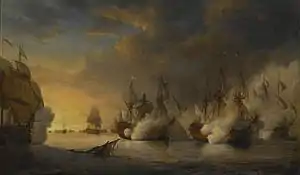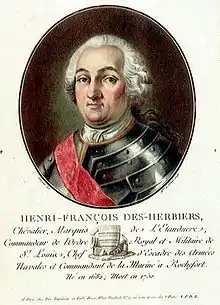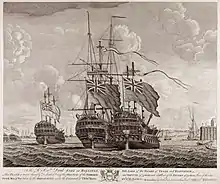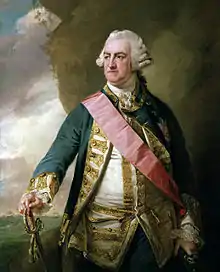Second Battle of Cape Finisterre (1747)
The Second Battle of Cape Finisterre was a naval battle which took place on 25 October 1747 (14 October 1747 in the Julian calendar then in use in Great Britain)[note 1] during the War of the Austrian Succession. A British fleet of fourteen ships of the line commanded by Rear-admiral Edward Hawke intercepted a French convoy of 250 merchant ships protected by eight ships of the line commanded by Vice Admiral Henri-François des Herbiers.
| Second Battle of Cape Finisterre | |||||||
|---|---|---|---|---|---|---|---|
| Part of the War of the Austrian Succession | |||||||
 French battleship Intrépide fighting several British ships, by Pierre-Julien Gilbert | |||||||
| |||||||
| Belligerents | |||||||
|
|
| ||||||
| Commanders and leaders | |||||||
| Rear-admiral Edward Hawke | Vice Admiral Henri-François des Herbiers | ||||||
| Strength | |||||||
| 14 ships of the line |
8 ships of the line 252 merchantmen and others | ||||||
| Casualties and losses | |||||||
|
154 killed 558 wounded |
6 ships of the line captured 800 killed and wounded, 4,000 captured 7 merchant ships captured | ||||||
When the two forces sighted each other, Herbiers ordered the merchant ships to scatter, formed his warships into a line of battle and attempted to draw the British warships towards him. In this he was successful, the British advanced on the French warships with little care for their formation, enveloped the rear of the French line and brought superior numbers to bear on the French vessels one at a time. Six of the French ships of the line were captured, along with 4,000 of their seamen. It was a complete British victory, isolating the French colonies from supply and reinforcement and the following year the war ended. Under the Treaty of Aix-la-Chapelle France recovered her colonial possessions in return for withdrawing from her gains in the Austrian Netherlands (modern Belgium).
Background
The War of the Austrian Succession (1740 – 1748) involved France, Spain and Prussia fighting Britain, Austria and the Dutch Republic. French military strategy focused on potential threats on its eastern and northern borders,[2] while Its colonies were left to fend for themselves, or given minimal resources, anticipating they would likely be lost anyway.[3] This strategy was driven by a combination of geography, and the superiority of the British navy, which made it difficult for the French navy to provide significant supplies and support to French colonies.[4] The expectation was that military victory in Europe would compensate for any colonial losses; if necessary gains in Europe could be exchanged for the return of captured colonial possessions.[5] The British tried to avoid large-scale commitments of troops to Europe,[6] taking advantage of its perceived naval superiority to expand in the colonies[7] and pursue a strategy of naval blockade.[8]
Prelude
In spring 1747 a French fleet of six ships of the line, the largest warships of the time, and five Indiamen, commanded by Jacques-Pierre de la Jonquière, were escorting a convoy of forty merchantmen bound for the Caribbean and North America. They were intercepted on 3 May by a British force of fourteen ships of the line, commanded by George Anson.[9][10] In the ensuing five hour First Battle of Cape Finisterre the French lost all six ships of the line captured, as well as two frigates, two Indiamen and seven merchantmen.[11][12] The fierce French resistance did enable most of the merchant ships to escape. On 20 June eight British ships under Commodore Thomas Fox intercepted a large French convoy inbound from the West Indies. The escorting French warships fled and of the 160 merchantmen, 48 were captured.[10]
By summer Anson was based ashore, in London, and his subordinate, Admiral Peter Warren,[13] commander of the Western Squadron,[10] was ill with scurvy.[14] So recently promoted Rear-admiral Edward Hawke[15] was given command of a squadron of fourteen ships of the line which sailed from Plymouth on 9 August.[16] Hawke introduced a new, and potentially more aggressive, system of signalling between ships[17][18] and instilled into his captains something of his own desire to give getting to grips with the enemy priority over rigid adherence to Admiralty sailing orders.[13] An unusually large French convoy with a strong escort was assembling in Basque Roads, intending to sail for the West Indies.[19] Hawke was tasked with intercepting it.[13] Relatively inexperienced, Hawke was given detailed orders,[20] which he ignored. He sailed well outside the limits laid down in his orders in his efforts to ensure that the convoy did not get past him.[13] It seems that Hawke was not aware of their contents until the day after he found and defeated the French.[note 2][20] The French, commanded by Vice Admiral Henri-François des Herbiers set off on 6 October.[19]
Battle

The French were sighted by the British squadron eight days after sailing, off Cape Finisterre, early on the morning of 14 October.[13][19] The British squadron still consisted of the fourteen ships of the line which had sailed, but they were all on the smaller side for such ships; the number of guns which they were rated to carry varied from 74 to 50, only one being rated for more than 66 guns.[19] The French convoy was unusually large, consisting of 250 merchant ships,[21] escorted by eight ships of the line and an Indiaman. The French ships were variously rated for 56 to 80 guns, with five being rated for 70 guns or more.[19]
At first Hawke thought he was up against a much larger fleet of warships, and formed a line of battle.[22] Herbiers initially mistook the British ships for members of the French convoy; on realising his mistake he decided to use his warships to divert the British in order to allow the merchant ships to disburse, which he hoped would allow most of them to avoid capture.[13][23] Hawke gave the flag signal for "general chase", ordering each of his ships to head towards the enemy at its maximum speed. The French had by now formed their own line of battle; the Indiaman Content and the smaller French ships stayed with the merchantmen. When within about 4 miles (6.4 km) of the French line, Hawke slowed the advance to permit his slower moving ships to catch up. Herbiers edged his line away from the scattering merchantmen: either the British had to pursue the French warships, permitting the French merchant ships to escape; or they could pursue the merchantmen and run the risk of being attacked from the rear by Herbiers. About 11:00 Hawke again ordered "general chase" and closed with the French warships.[13]
.jpeg.webp)
The British attacked with the French rear in a very loose formation, but three British ships were able to get on to the far side of the French line. This meant that three French ships were attacked on both sides by the British. By being able to attack a single French ship with two of their own, the British were able to compensate for their own ships being individually weaker; in addition, the three rearmost French ships were their weakest. By 13:30 two of them had surrendered.[24] The British repeated the procedure as they moved up the French line,[14] bringing several of their ships to bear on each of the French and commencing each attack by firing canister shot into the French rigging so as to immobilise them. By 15:30 another pair of French ships had struck their colours.[note 3][26][27]
Of the remaining four French ships, three were engaged in running battles with superior forces of British ships, and each of them had their mobility restricted due to damage to their rigging. The French flagship, the Tonnant, the most powerful vessel in either squadron, was holding off her opponents, but was surrounded. The leading French ship, the Intrépide, having not yet been fully engaged, turned back into the fight. With her assistance, Tonnant was able to break free and the two ships escaped to the east, fruitlessly pursued by the British. The final pair of French ships, attacked on all sides, also surrendered. Most of the British ships had attacked as aggressively as Hawke had wished, closing to "pistol shot" range – that is to say, very close range. One ship which Hawke felt was less committed was the Kent; her captain was subsequently court martialled and dismissed from the navy.[28]
The British lost 154 men killed and 558 wounded in the battle. The French lost approximately 800 killed and wounded[29] and had 4,000 men taken prisoner.[30] Herbiers did succeed in his objective of protecting the convoy,[28] of the 250 merchantmen, only seven were captured.[31] The balance continued to the West Indies, but, warned of their approach, the British Leeward Islands Squadron under Commodore George Pocock was able to intercept many of them in the winter of 1747–48.[20][30]
Aftermath

Warren exulted to the British government "we have more French ships in our ports than remain in the ports of France".[20] The battle convinced the French government of its helplessness at sea, and it made no further efforts to fight convoys through the British blockade. This soon brought most of France's colonies close to starvation, particularly in the West Indies, where the French possessions were not self sufficient in food. France to the negotiating table despite her victories in the Low Countries and elsewhere.[32] A further consequence of the battle, along with Anson's earlier victory, was to give the British almost total control in the English Channel during the final months of the war.[33] It proved ruinous to the French economy and to French national creditworthiness, helping the British to secure an acceptable peace.[34] In 1748 the Treaty of Aix-la-Chapelle was agreed, bringing the war to an end. France recovered her colonial possessions in return for withdrawing from her gains in the Austrian Netherlands (modern Belgium).[5] The psychological impact of the battles of Cape Finisterre continued into the Seven Years' War (1756–1763), when the French King would prove reluctant to send men and supplies to French Canada and his other colonies.[35]
Order of battle
Britain (Edward Hawke)
- Devonshire 66 (flag, John Moore)[note 4]
- Edinburgh 70 (Thomas Cotes)
- Kent 64 (Thomas Fox)
- Yarmouth 64 (Charles Saunders)
- Monmouth 64 (Henry Harrison)
- Princess Louisa 60 (Charles Watson)
- Windsor 60 (Thomas Hanway)
- Lion 60 (Arthur Scott)
- Tilbury 60 (Robert Harland)
- Nottingham 60 (Philip de Saumarez)
- Defiance 60 (John Bentley)
- Eagle 60 (George Brydges Rodney)
- Gloucester 50 (Philip Durell)
- Portland 50 (Charles Stevens)[19][21]
France (Henri-François des Herbiers)
- Tonnant 80 (flag, Duchaffault) – escaped
- Intrépide 74 (Comte de Vaudreuil) – escaped
- Terrible 74 (Comte du Guay) – captured
- Monarque 74 (de la Bédoyère) – captured
- Neptune 70 (de Fromentière) – captured
- Trident 64 (Marquis d'Amblimont) – captured
- Fougueux 64 (du Vignau) – captured
- Severn 56 (du Rouret de Saint-Estève) – captured
- Content 64[note 5] – escaped with merchant ships
- Castor 26 – escaped with merchant ships
- Convoy of 250 merchant ships[19][21]
Notes, citations and sources
Notes
- Following the normal convention, all dates are Old Style and use the Julian calendar; they also assume that each year starts on 1 January.[1]
- The naval historian Nicholas Rodger states that the orders had been "mysteriously 'mislaid' ". Quotation marks in original.[20]
- A ship's "colours", a national flag or battle ensign, are hauled down from her mast, or "struck", to indicate that the ship has surrendered.[25]
- The number after each ship indicates number of guns it was rated to carry. The name in parentheses is that of the captain of the ship.
- Content was an Indiaman.[21]
Citations
- Rodger 2004, p. xix.
- Borneman 2007, p. 80.
- Pritchard 2004, p. 356.
- Dull 2007, p. 14.
- Lee 1984, p. 285.
- Till 2006, p. 77.
- Black 1998, p. 45.
- Vego 2003, pp. 156–157.
- Troude 1867, pp. 311–313.
- Rodger 2004, p. 252.
- Troude 1867, pp. 314–315.
- Allen 1852, p. 160.
- Tracy 2010, p. 61.
- Sweetman 1997, p. 156.
- Rodger 2004, pp. 252–253.
- Tracy 2010, pp. 61–62.
- Tracy 2010, pp. 59–60.
- Rodger 2004, p. 255.
- Allen 1852, p. 162.
- Rodger 2004, p. 253.
- Troude 1867, p. 316.
- Black 1998, p. 97.
- Allen 1852, p. 163.
- Tracy 2010, p. 62.
- Wilhelm 1881, p. 148.
- Willis 2009, p. 761.
- Tracy 2010, pp. 62–63.
- Tracy 2010, p. 63.
- Allen 1852, pp. 164–165.
- Black 1998, p. 100.
- Allen 1852, p. 165.
- Black 1998, pp. 97–100.
- Rodger 2004, pp. 253–255.
- Lambert 2009, p. 137.
- Tucker 2009, p. 754.
Sources
- Allen, Joseph (1852). Battles of the British Navy. 1. London: Henry G. Bohn. OCLC 7155299.
- Black, Jeremy (1998). Britain as a Military Power, 1688–1815. London: Routledge. ISBN 978-1-85728-772-1.
- Borneman, Walter R. (2007). The French and Indian War: Deciding the Fate of North America. New York; Toronto: HarperCollins. ISBN 978-0-060-76184-4.
- Dull, Jonathan R. (2007). The French Navy and the Seven Years' War. Lincoln, Nebraska: University of Nebraska Press. ISBN 978-0-803-21731-7.
- Lambert, Andrew (2009). Admirals: The Naval Commanders Who Made Britain Great. London: Faber and Faber. ISBN 978-0571231577.
- Lee, Stephen J. (1984). Aspects of European History, 1494–1789. London: Routledge. ISBN 978-0-416-37490-2.
- Pritchard, James (2004). In Search of Empire: The French in the Americas, 1670–1730. Cambridge: Cambridge University Press. ISBN 978-0-521-82742-3.
- Rodger, N.A.M. (2004). The Command of the Ocean. London: Penguin. ISBN 0713994118.
- Sweetman, Jack (1997). The Great Admirals: Command at Sea, 1587-1945. Annapolis: Naval Institute Press. ISBN 978-0-87021-229-1.
- Till, Geoffrey (2006). Development of British Naval Thinking: Essays in Memory of Bryan Ranft. London; New York: Routledge. ISBN 978-0-714-65320-4.
- Tracy, Nicholas (2010). The Battle of Quiberon Bay, 1759: Hawke and the Defeat of the French Invasion. Barnsley, South Yorkshire: Pen & Sword. ISBN 978-1848841161.
- Troude, Onesime-Joachim (1867). Batailles navales de la France, Volume 1 (in French). Paris: Libraire Commissionaire de la Marine. OCLC 757299734.
- Tucker, Spencer (2009). A Global Chronology of Conflict: From the Ancient World to the Modern Middle East. Santa Barbara: ABC-CLIO Ltd. ISBN 978-1851096671.
- Vego, Milan N. (2003). Naval Strategy and Operations in Narrow Seas. London: Frank Cass. ISBN 978-0-714-65389-1.
- Wilhelm, Thomas (1881). A Military Dictionary and Gazetteer. Philadelphia: L. R. Hamersly & Co. OCLC 1872456.
